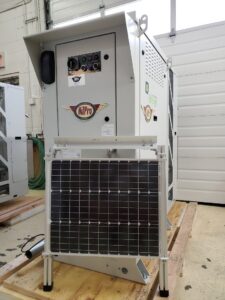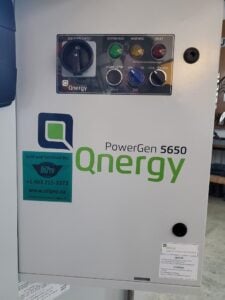
Are you concerned with the carbon footprint produced by your choice of remote power? If you want to ensure you’re doing your part to help the environment with your choice of remote power, you can have both a reliable and low emission option.
Here’s how PowerGen provides a lower carbon footprint versus alternate remote site critical power generation systems.
- Lower lifetime carbon footprint
To calculate a remote power option’s carbon footprint, we must take into account the total lifetime carbon footprint of an engine.
The Free-Piston Stirling Engine (FPSE) was declared by NASA to be “the most reliable generation technology in history”. It’s what makes the PowerGen by Qnergy the first choice for remote power and why OilPro proudly supports this line.
The FPSE requires minimal scheduled maintenance and component replacement/service. It requires no oil changes so fewer visits to PowerGen sites mean less carbon-intensive maintenance.
This is why the PowerGen compares favourably versus internal combustion engines but also compared to fuel cells both of which require replacement of major components at regular intervals.
2. Better energy efficiency
The PowerGen provides additional carbon footprint reductions by using its own waste heat to circulate hot glycol on site. This raises the PowerGen’s overall efficiency from the roughly 20% – 30%+ range into the 70% – 90% range.
Converting energy on site using gas available on-site fuel is extremely efficient. Once one considers fuels such as gasoline, diesel or processed gas can ultimately result in an overall energy conversion rate as low 10-20% at the driven wheel after all the losses throughout the processing and distribution networks, decentralized power generation makes a lot of sense.
Similar losses apply to centrally generated and distributed electricity networks, regardless of the means used to generate power, due to line losses in distribution.

3. Reduced reliance on backup battery storage
Due to its significant power output compared to conventional remote power sources like ThermoElectric Generators, the PowerGen can help recover drained onsite energy storage more quickly.
As the charge rate is much higher, lower reserves are required. Solar and wind power require even more battery backup due to their intermittent and seasonally variable nature.
We all know that our car batteries eventually die with a typical lifespan of 2-5 years. Reducing the amount of required backup power causes a significant reduction in the carbon footprint of the overall system PowerGen is part of.
PowerGen customers are also using the Glycol Heat Trace (GHT) option to keep batteries within their most efficient temperature range, further extending battery life and reducing the need for additional backup in low temperature operations.
4. Increased efficiency as temperatures decrease
The PowerGen becomes more efficient the colder the ambient temperatures are, which happens to coincide with PowerGen customer’s greatest reliance on continued operation of their facilities.
Many remote power options stop working when the temperature drops below a certain temperature. When you need remote power, you need it to be available 24/7 regardless of the weather conditions.
Fewer emergency shut-downs mean fewer unscheduled site visits, which means fewer hydrocarbons burned calling in staff, trucks and steaming equipment for unscheduled visits.
Summary
Would you like to learn more about how to understand your company’s total carbon footprint and how to lower it? Check out our other related articles on the subject including What Is Your Company’s Total Carbon Footprint and The Importance of Total Carbon Footprint for more information.
